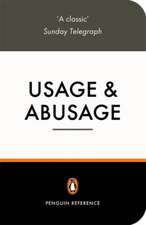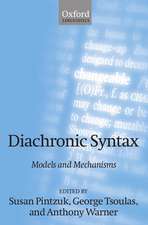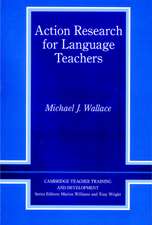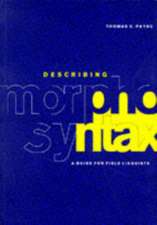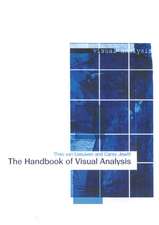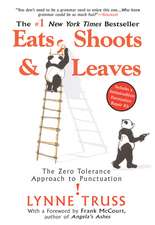Introducing Multimodality
Autor Carey Jewitt, Jeff Bezemer, Kay O'Halloranen Limba Engleză Paperback – 31 mar 2016
- formulating research questions
- collecting research materials
- assessing and developing methods of transcription
- considering the ethical dimensions of multimodal research.
| Toate formatele și edițiile | Preț | Express |
|---|---|---|
| Paperback (1) | 357.43 lei 6-8 săpt. | |
| Taylor & Francis – 31 mar 2016 | 357.43 lei 6-8 săpt. | |
| Hardback (1) | 1006.60 lei 6-8 săpt. | |
| Taylor & Francis – apr 2016 | 1006.60 lei 6-8 săpt. |
Preț: 357.43 lei
Nou
Puncte Express: 536
Preț estimativ în valută:
68.40€ • 74.27$ • 57.46£
68.40€ • 74.27$ • 57.46£
Carte tipărită la comandă
Livrare economică 22 aprilie-06 mai
Preluare comenzi: 021 569.72.76
Specificații
ISBN-13: 9780415639262
ISBN-10: 0415639263
Pagini: 232
Ilustrații: 90
Dimensiuni: 174 x 246 x 12 mm
Greutate: 0.48 kg
Ediția:1
Editura: Taylor & Francis
Colecția Routledge
Locul publicării:Oxford, United Kingdom
ISBN-10: 0415639263
Pagini: 232
Ilustrații: 90
Dimensiuni: 174 x 246 x 12 mm
Greutate: 0.48 kg
Ediția:1
Editura: Taylor & Francis
Colecția Routledge
Locul publicării:Oxford, United Kingdom
Public țintă
Postgraduate and UndergraduateCuprins
List of illustrations
About this book
Acknowledgements
Chapter 1: Navigating a diverse field
Chapter 2: Why engage with multimodality?
Chapter 3: Systemic Functional Linguistics
Chapter 4: Social Semiotics
Chapter 5: Conversation Analysis
Chapter 6: Five more approaches to multimodality
Chapter 7: Designing a multimodal study
Glossary
Self-study guide
References
Index
About this book
Acknowledgements
Chapter 1: Navigating a diverse field
Chapter 2: Why engage with multimodality?
Chapter 3: Systemic Functional Linguistics
Chapter 4: Social Semiotics
Chapter 5: Conversation Analysis
Chapter 6: Five more approaches to multimodality
Chapter 7: Designing a multimodal study
Glossary
Self-study guide
References
Index
Recenzii
"A comprehensive and insightful overview of up-to-date approaches to multimodality with detailed accounts of both their shared and distinctive theories of meaning and methods of analysis, using an array of representative study examples as illustrations. It is very comprehensible, requiring "no prior knowledge in linguistics or semiotics" on the part of readers and thus serves as a good starting point for novices in multimodality. It is also an excellent reference for established scholars who wish to deepen their insights into the complexities involved in various strands of multimodal research." Enhua Guo (2017): Introducing multimodality, Social Semiotics
"An excellent guide to multimodality for learners who want to establish their research into multimodality, for this book presents eight approaches all together and sheds light on the distinctions, critiques and new directions of them … the book offers a panoramic overview of fresh trends and developments in multimodality. Elaboration of those approaches is supported by the exemplification of recently published or still-in-press studies." Rurong Le, Multimodal Commun. 2016; 5(2): 143–144
'This exquisitely readable and user-friendly book introduces students to what is perhaps the most stimulating and exciting recent development in semiotic and discourse analysis. Written by some of the most dynamic and innovative scholars in the field of multimodality, this book promises to become a classic and remain an indispensable reference text for many years to come.' Jan Blommaert,Tilburg University, the Netherlands
'Finally a textbook which clearly and authoritatively brings together the different strands in multimodal theory and research and empowers students to explore multimodal communication through their own research.' Theo van Leeuwen,University of Technology Sydney, Australia
'A comprehensive and even handed review of a range of perspectives on multimodality, followed by wise advice on the design and conduct of research studies.' Frederick Erickson,University of California, USA
"A comprehensive and insightful overview of up-to-date approaches to multimodality with detailed accounts of both their shared and distinctive theories of meaning and methods of analysis, using an array of representative study examples as illustrations. It is very comprehensible, requiring "no prior knowledge in linguistics or semiotics" on the part of readers and thus serves as a good starting point for novices in multimodality. It is also an excellent reference for established scholars who wish to deepen their insights into the complexities involved in various strands of multimodal research." Enhua Guo (2017): Introducing multimodality, Social Semiotics
"An excellent guide to multimodality for learners who want to establish their research into multimodality, for this book presents eight approaches all together and sheds light on the distinctions, critiques and new directions of them … the book offers a panoramic overview of fresh trends and developments in multimodality. Elaboration of those approaches is supported by the exemplification of recently published or still-in-press studies." Rurong Le, Multimodal Commun. 2016; 5(2): 143–144
"An excellent guide to multimodality for learners who want to establish their research into multimodality, for this book presents eight approaches all together and sheds light on the distinctions, critiques and new directions of them … the book offers a panoramic overview of fresh trends and developments in multimodality. Elaboration of those approaches is supported by the exemplification of recently published or still-in-press studies." Rurong Le, Multimodal Commun. 2016; 5(2): 143–144
'This exquisitely readable and user-friendly book introduces students to what is perhaps the most stimulating and exciting recent development in semiotic and discourse analysis. Written by some of the most dynamic and innovative scholars in the field of multimodality, this book promises to become a classic and remain an indispensable reference text for many years to come.' Jan Blommaert,Tilburg University, the Netherlands
'Finally a textbook which clearly and authoritatively brings together the different strands in multimodal theory and research and empowers students to explore multimodal communication through their own research.' Theo van Leeuwen,University of Technology Sydney, Australia
'A comprehensive and even handed review of a range of perspectives on multimodality, followed by wise advice on the design and conduct of research studies.' Frederick Erickson,University of California, USA
"A comprehensive and insightful overview of up-to-date approaches to multimodality with detailed accounts of both their shared and distinctive theories of meaning and methods of analysis, using an array of representative study examples as illustrations. It is very comprehensible, requiring "no prior knowledge in linguistics or semiotics" on the part of readers and thus serves as a good starting point for novices in multimodality. It is also an excellent reference for established scholars who wish to deepen their insights into the complexities involved in various strands of multimodal research." Enhua Guo (2017): Introducing multimodality, Social Semiotics
"An excellent guide to multimodality for learners who want to establish their research into multimodality, for this book presents eight approaches all together and sheds light on the distinctions, critiques and new directions of them … the book offers a panoramic overview of fresh trends and developments in multimodality. Elaboration of those approaches is supported by the exemplification of recently published or still-in-press studies." Rurong Le, Multimodal Commun. 2016; 5(2): 143–144
Notă biografică
Carey Jewitt is Professor of Technology and Learning at University College London, Institute of Education. She has authored/edited a number of books on multimodality, including The Routledge Handbook of Multimodal Analysis (2009/2014), Technology, Literacy and Learning: A Multimodal Approach (2008), Urban English Classrooms: Multimodal Teaching and Learning (2005), with Gunther Kress and colleagues, and The Rhetorics of the Science Classroom: A Multimodal Approach (2001), with Gunther Kress and colleagues.
Jeff Bezemer is Reader in Learning and Communication and Co-Director of the Centre for Multimodal Research at University College London, Institute of Education. He is co-author of Multimodality, Learning and Communication (with Gunther Kress, 2015).
Kay O’Halloran is Associate Professor of Communication Studies at Curtin University, Western Australia. Her publications include Multimodal Analysis Image (2012), Multimodal Studies: Exploring Issues and Domains (2011), Mathematical Discourse: Language, Symbolism and Visual Images (2005) and Multimodal Discourse Analysis (2004).
Jeff Bezemer is Reader in Learning and Communication and Co-Director of the Centre for Multimodal Research at University College London, Institute of Education. He is co-author of Multimodality, Learning and Communication (with Gunther Kress, 2015).
Kay O’Halloran is Associate Professor of Communication Studies at Curtin University, Western Australia. Her publications include Multimodal Analysis Image (2012), Multimodal Studies: Exploring Issues and Domains (2011), Mathematical Discourse: Language, Symbolism and Visual Images (2005) and Multimodal Discourse Analysis (2004).
Descriere
This accessible textbook introduces multimodality: its origins, scope and the potential of multimodal research for understanding the ways in which people communicate. Readers will learn to recognize similarities and differences in theoretical and methodological positions, and the limitations of different approaches are highlighted, including advice on how to mix and ultimately choose the most apt approaches for a study. With a wide range of examples, clear practical support and a glossary of terms, Introducing Multimodality is an ideal reference for undergraduate and postgraduate students in multimodality and semiotics within applied linguistics, education, media and communication studies.

